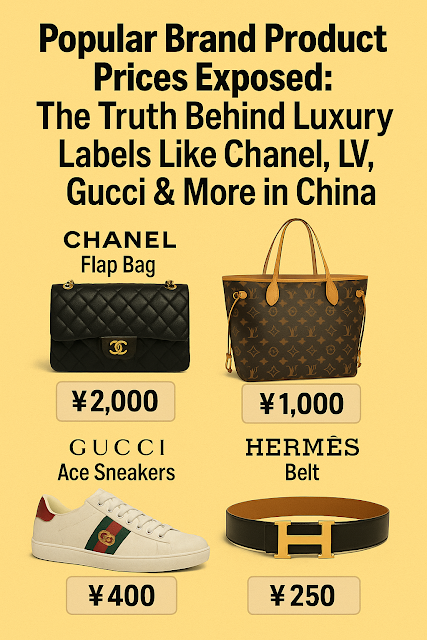Popular Brand Product Prices Exposed: The Truth Behind Luxury Labels Like Chanel, LV, Gucci & More in China
Luxury brands like Chanel, Louis Vuitton (LV), Gucci (GG), Hermès, and others have long been symbols of wealth, class, and exclusivity. But behind the glam and glitz lies an intriguing question that’s recently gone viral across social media: How much do these luxury products really cost to make? And are Chinese consumers paying more than they should?
Let's break down the mystery behind the real prices of luxury goods, the shocking profit margins, and how China's booming luxury market plays a major role.
💼 Luxury Brands in China: A Booming Market
China is one of the largest consumers of luxury goods in the world. According to recent industry reports, Chinese buyers account for over one-third of global luxury spending. From LV handbags to Gucci belts, luxury fashion is not just about style—it's also about status and social recognition.
But here’s where things get interesting: recent investigations and videos have exposed the actual cost of production for many iconic luxury items.
🧵 Shocking Price Breakdowns: What They Actually Cost to Make
👜 Chanel Flap Bag – Retail Price: ¥70,000+ (~$9,600 USD)
Estimated Manufacturing Cost: ¥2,000–¥3,000 (~$275–$410 USD)
🟢 Made with lambskin, chain hardware, and lining
🟢 Mass-produced in select factories, with design costs long recouped
👛 Louis Vuitton Neverfull MM – Retail Price: ¥16,800 (~$2,300 USD)
Estimated Manufacturing Cost: ¥1,000–¥1,500 (~$140–$210 USD)
🟢 Coated canvas and leather trim
🟢 Massive markup for branding and exclusivity
👟 Gucci Ace Sneakers – Retail Price: ¥6,500 (~$890 USD)
Estimated Manufacturing Cost: ¥400–¥600 (~$55–$85 USD)
🟢 Basic leather construction with embroidered logo
🟢 Manufactured in Europe, but some components outsourced
💰 Why Are Luxury Prices So High?
Luxury brands justify their prices using terms like “heritage,” “craftsmanship,” and “exclusive design.” But the reality is, a huge portion of the cost goes into:
-
💼 Marketing & celebrity endorsements
-
🏬 Flagship stores in premium locations
-
💎 Packaging, exclusivity & brand image
-
📈 Sky-high profit margins
According to industry insiders, some products carry margins of over 1,000%. That means you’re paying 10x more than what the item costs to produce.
📦 What About ‘Made in China’ Luxury Items?
Many consumers are surprised to learn that some components—or even full products—are manufactured in China or other low-cost countries, despite labels saying “Made in Italy” or “Made in France.”
🔍 Fact: Certain luxury houses have their stitching or assembly done in Europe but source materials, hardware, or labor from China or Vietnam to cut costs.
🇨🇳 China’s New Trend: Smart Luxury Buying
With growing awareness, Chinese consumers are becoming more price-savvy:
-
✈️ Buying luxury goods during overseas travel to avoid local markup
-
🛍️ Using daigou agents to source cheaper international versions
-
🔎 Turning to “quiet luxury” or independent designers offering quality without the brand tax
⚠️ The Fine Line: Is It Worth It?
Luxury brands are not just selling a product—they’re selling a lifestyle and a dream. For many, that dream is worth the price. But for others, the exposure of the true cost vs. retail markup is sparking a wave of conscious consumerism.
🔚 Final Thoughts
Luxury fashion has always had its allure, but as more insiders reveal the real costs, shoppers in China and beyond are beginning to ask, “What am I really paying for?”
So, before you drop ¥30,000+ on a handbag, remember: the price might reflect the brand’s image more than the bag’s true value.
.jpg)

%20(1).jpg)
Comments
Post a Comment